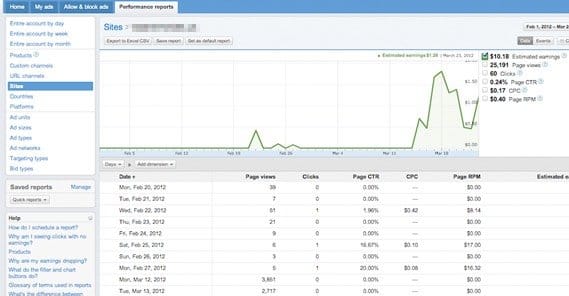35 of The Highest Earning Cost Per Impression Networks

When you’re looking to earn money from a CPM ad, you’re taking the role of a publisher. You’re the person with the website, and it’s your traffic and your screen real estate put up for ad placement. You have some control over the ads that run, but a lot of it will rely on your topic and content.
CPM, or Cost Per Mille, is advertising that pays per thousand views. The more traffic you have, the more people who see the ads, the more you get paid. To maximize the payments you get, you can shop around for a high quality ad network, one that will place good ads with optimized copy. Low quality ad networks often drop views, showing that a portion of the traffic you referred is “unqualified” for their standards.
Payouts

Different CPM networks have different types of ads on offer. Some of them will do anything. Others specialize in, for example, video ads or mobile ads.
A big part of making money through CPM on your site is identifying which types of ads are most likely to be seen on your site, and thus when networks you should pursue. Of course, the best way to do it is just to enroll with several networks and run ads anywhere you can. Still, some will be better than others.
MonetizePros, one of the information leaders in CPC and CPM advertising, has aggregated data about the average earnings for various types of ads. According to their data, website display ads are the cheapest at around $2.80 per thousand. Video ads are next up with $3.00. Email ads are more valuable – did you know you can run CPM in email newsletters? – and pull in an average of $5.00. Mobile ads, meanwhile, vary highly depending on the niche and the goal of the mobile ad. This is due to the dramatic difference between pay for interstitial mobile ads and pay for mobile banners.
Granted, there aren’t many verified data points for these figures, but you can use them as a general average to see if a network you’re investigating is a scam.
What about niches? These can vary dramatically in price depending on the network as well, and it relies a lot on their relationships with advertisers. The sites with higher payouts have better relationships, but they also have higher standards for the sites they accept as publishers.
The lowest of the low payouts are in entertainment, gaming, beauty and architecture, all under $.50. The highest of the high, meanwhile, are in finance and technology, both over $10. Variance is huge, though; the lowest of entertainment is $.35, while the highest is $7.10. Always investigate the networks you’re running, and keep an eye out for better offers from other sites.
There are some ways you can boost your earnings in addition to impression-based share. One is revenue share; some networks offer an increased payout based on the value of the conversions coming from your impressions. This turns your CPM ads into hybrid CPM/Affiliate ads, in essence; traffic and views get you paid, but you have a valuable benefit to getting conversions as well.
The other method would be referral programs, where you might earn 10% or more of what the people you refer earn. This incentivizes referring high quality sites that have the potential to earn a lot of money. Catch them early, though; many such sites already have their contracts drawn.
Improving CPM Performance
A lot of CPM networks are going to a programmatic model these days, simply because computer algorithms learn faster, optimize better, and have better judgment than humans. So if you’re going for a programmatic ad network – which many of the list are – what can you do to make your earnings grow?
- Give the site more data. The more audience data, the more contextual data, and the more site data you provide, the more accurate the programmatic algorithms will be. Page-level information allows more precise optimizations, so you can look at individual ads to improve rather than making broad, site-wide changes.
- Make changes to your site to support larger, higher priced ad units. High-impact ad units like cross-screen ads and interstitials are much higher converting, but they’re also only effective for certain types of sites. If you can change a design to implement them, you can come out with higher CPM rates all around.
- Test. Test ads, test networks, test offers, test designs, test everything you can possibly think of to test.
Obviously, any change you make that brings in more traffic is a chance to make more money. When you’re paid per thousand valid views, bringing in more views means bringing in more money. The problem, of course, is finding legitimate ways to bring in that traffic. It’s difficult to use PPC to bring in traffic, for two reasons.
For one thing, a lot of times the traffic you get from PPC isn’t always going to be valid. You’ll encounter a lot of bot traffic and a lot of low quality traffic that falls outside the valid demographics of the ad networks you’re using for CPM. For another thing, if you’re making $1 per thousand views, but $1 only brings you 50 views from a PPC ad, you’re losing money. You need exceptionally high CPM and exceptionally low PPC to make that work, and in almost every situation, it won’t work.
Always be aware of your fill rate and your ad density. Fill rate should be as close to 100% as possible, because if you’re ever having a page load without an ad, that’s a view you’re not getting paid for. Ad density, meanwhile, should be low. You’re going to want to operate in a quality over quantity mindset, here.
Feel free to explore other ad networks. You can separate different parts of your site into segments and run different ad networks on different segments. So long as you’re not misrepresenting your traffic statistics for what you’re giving to a network, they generally won’t care. You always want to be on the lookout for a good deal.
There’s also the step up technique. Many ad networks are stingy with who they let in as publishers, and they want good credentials for past networks and past performance. You won’t have that starting off, so you have to go with some poor quality ad networks just to get the “resume experience” so to speak. Work with one for a few months, then apply to a higher tier network. After a while, you’ll be able to get into some of the higher tier networks without necessarily having the traffic to back it up, just based on your credentials.
The List
Now, because so many existing lists of CPM networks are out of date, I’m going to try to list the previous names of many of these networks, or the networks they control as holding companies.
This is primarily so those of you with prominent names in mind don’t worry when I don’t list them; those names may have changed. The world of advertising changes every year, and with it comes a lot of rebranding, a lot of collapsed networks, and a lot of confusion.
- Google AdSense – AdSense is, of course, the gold standard with CPM advertising. You can hardly do better. Some sites might pay more, some sites might have better ads, but no network is all-around better in every way.
- Conversant Media (Formerly ValueClick) – Conversant is the home of CJ Affiliate, one of the most popular affiliate marketing networks on the web, so it stands to reason that they’re a potent and valuable choice.
- Vibrant Media – This network is great because of some of the tools and features they offer, including the ability to reject categories or specific ads, as well as SafeServe, a content filter that eliminates inappropriate content before it reaches your site.
- Advertising.com – One of the oldest and largest networks, Advertising.com boasts over two billion impressions every day, with all of the power and sway that implies. They have direct relationships with 74 of the top 100 sites ranked by ComScore.
- RhythmOne (Formerly Burst Media) – One of the primary evolutions of this network in their change from Burst Media is the cross-screen and cross-platform advertising, that works with video as well as site content.
- Index Exchange (Formerly Casale Media) – A relatively recent rebranding, this change keeps all of the benefits of Casale while giving it a more corporate and large-scale reach.
- SiteScout (Formerly AdBrite) – This one is half network, half self-serve advertising platform using their custom real time banner advertising technology. Bidding, statistics, reporting and serving are all done in real time, no delays.
- DoubleClick (By Google) – One of the oldest networks around, DoubleClick was picked up by Google some years ago and has since boosted their quality and performance immensely.
- IDG Tech Network – This network has mobile, video and display advertising to make sure it catches all of your traffic, regardless of platform or destination. However, they’re in a relatively narrow and competitive niche, that being enterprise/tech/gaming.
- Sulvo X – One of the driving reasons to adopt this network is that they have a very interesting offer. If you don’t make more with them than you were making from your previous ad network, they will straight-up give you $500. It’s qualified, of course; you have to have never been banned, have proof of earnings, have minimum traffic thresholds and have most of your traffic coming from NA/EU.
- Gorilla Nation – This network does a lot of work with global Fortune 500 companies, with offices around the world. They’re also always trying to stay on the cutting edge of new technology and advertising methods. Are they always up front? Some more agile companies can move before they can, but they’re among the first.
- Chitika – One of the main features of this network is their native advertising. Their ads are designed to look like they fit within your content. They aren’t quite as seamless as some other solutions, but the other primary benefit of the network is automation. You don’t have to dig your hands in if you don’t want to.
- Ybrant Digital (Formerly AdDynamix) – This is the ad network side of Lycos, which evolved from a poor Google search competitor to a reasonably high quality online video provider, with a bunch of other tech on the side.
- Technorati – One part tech site, one part ad network, Technorati is based on the work of a bunch of engineers, and as such they have put together a learning and optimizing program that maximizes fill rate while also providing the most effective ads at any given time.
- AdTegrity – This network calls their publishers “inventory partners” and if that doesn’t tell you all about them, I don’t know what will. Well, I guess their publishers page. They’re very picky with the sites they accept, and they don’t allow affiliate or referral sites, pay sites, proxy sites, adult sites or sites that so much as reference illegal activities.
- PulsePoint (Formerly ContextWeb, Formerly AdsDAQ) – The rebranding and merging going on here is almost astonishing. Now, they have both programmatic and content marketing ad solutions. Next year? Who knows.
- BannerConnect – Even though they focus primarily on banner ads, this network puts customer service to the forefront and assigns real project managers to virtually every case, even those using programmatic ad serving.
- Axill – Paying Net30, my main gripe with this network is their use of Skrill rather than a solid payment option like PayPal or Google Wallet. They at least offer wire transfers, though. They’re growing quickly, at least, so there’s incentive to get in early.
- CPXi (Multiple Networks, Including Realtime, AdReady, and ConsumedMedia) – With several different networks to use, CPXi has solutions for sites of all stripes. I expect them to keep expanding and rolling in other networks as time goes on.
- Clicksor – This network is one of the larger names in the industry, boasting high revenue share for their publishers in addition to their other modes of CPM. Possibly their biggest draw is the referral program that can help an underperforming site still make money.
- Clickbooth – This network focuses on exclusive relationships with advertisers, high performance ads, a lot of testing, and active culling. If you don’t perform, you’re out. If you do, it’s a long and lucrative relationship.
- AdKnowledge (Formerly Cubics) – Video ads, social media ads, app ads, email ads, site ads; there’s something for everyone with this otherwise-standard ad network.
- Exponential (Formerly Tribal Fusion) – Tribal Fusion was one of the big names for a long time, and it tops almost every list from the era. Today, with the rebranding, it has maintained that reputation. They have plans for self-service and enterprise, with a lot of flexibility in usage.
- GumGum – This network is unique in that it focuses more on style and design over content and copy. Beautiful ads and compelling design with in-text and inline ads make for a unique experience.
- BlogHer Publishing Network – BlogHer is a network of specifically female-focused and female-written blogs, and becoming part of that network opens up a ton of options for those websites. It’s a surprisingly exclusive niche.
- Gourmet Ads – Where BlogHer is all about female blogging, Foodie is all about food and wine blogging. Food blogs, restaurant reviews, cooking techniques, recipe blogs, and wine; they’re all part of the network, and while the niche is narrow, there’s a lot of cooperation.
- Sovrn (Formerly Lijit) – This network promotes their support and engagement over other metrics, so while they might have a lower pay rate than some others, the relationships that develop are more valuable in comparison.
- Pop Ads – On one hand, this network pays any time you want, no net30 or net60 or whatever. Payments are made within 24 hours. On the other hand, they’re an ad network focusing on pop-ups and pop-unders, which really, really need to be used properly if you want any success with them.
- Infinity Ads – This is a global network with over 30,000 advertisers in every possible vertical. They offer some very valuable pop-unders and interstitial ads, if you can work them into your site properly. They also have a very low minimum payout, at just $3.
- CPMoz – No affiliation with Moz.com, this network has wide open requirements save for no adult sites, and they have a relatively high revenue share program in addition to their normal CPM.
- Robert Sherman Media – One of the oldest and goofiest-looking ad networks on this list, they’ve been in business since 1995, and they haven’t really changed their website since. That’s fine though; it’s what’s under the hood that counts.
- Morning Falls – This is a low volume ad network that works primarily to be an introductory network for many publishers who don’t meet the minimum thresholds to get in with other networks right away.
- AdPepper – This site has both German and Spanish versions in addition to English, and it’s primarily focused on a European audience. They have some great high-profile clients too.
Honorable Mentions
Last we checked, these sites stopped loading. If they come back online, please let us know!
- AdsWisher (Dead?) – An innovative pop-under ad network that understands the negative connotation of the ad method and works to make them legit again. Last we checked their website, it wasn’t loading.
- Paid To Promote (Dead?) – If you’ve ever wanted to use an ad network that looks fresh out of a high school coding class, this is it. If not, maybe their automatic payments, referral program tiers, and very easy to use ad code will make the choice for you. This website stopped loading in October 2016.
 ContentPowered.com
ContentPowered.com






Great list, but you left out Adosia. They are an up and coming competitor that can maximize publisher revenue while providing optimal results for advertisers.